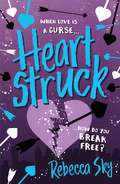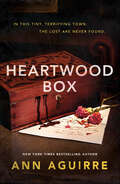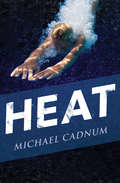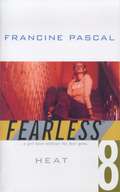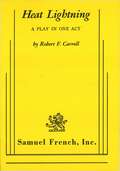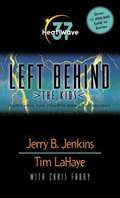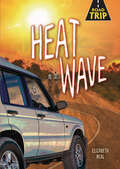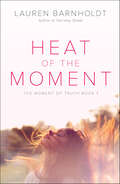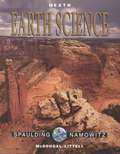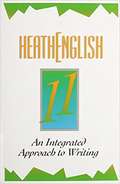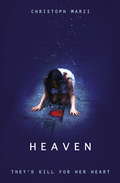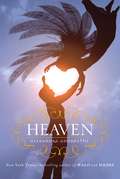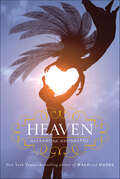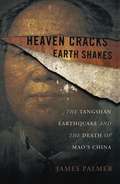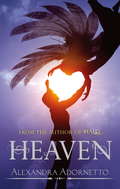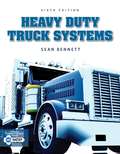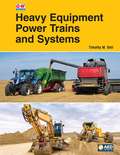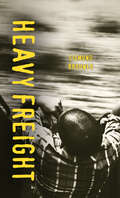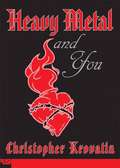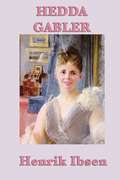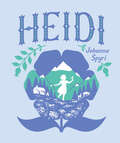- Table View
- List View
Heartstruck: Book 2
by Rebecca SkyWhat if you had the power to make any boy fall in love with you? Addictive romance with a fantasy twist for fans of Holly Smale, Ally Carter, and Zoe Sugg.The gods are gone.The people have forgotten them. But sixteen-year-old Rachel Patel can't forget - the gods control her life, or more specifically, her love life.Being a Hedoness, one of a strong group of women descended from Greek God Eros, makes true love impossible for Rachel. She wields the power of that magical golden arrow, and with it, the promise to take the will of any boy she kisses. But the last thing Rachel wants is to force someone to love her and in retribution for refusing to use her powers, the Hedoness Committee has taken her captive.Now, Rachel is being held in a secret facility. As she struggles to find a way to escape, Rachel must figure out who she can trust, rescue her family and friends, and maybe, just maybe...even find a way to fall in love.
Heartwood Box
by Ann AguirreStranger Things meets The Lakehouse in Heartwood Box, a dark, romantic YA suspense novel with an SF edge from New York Times bestselling author Ann Aguirre.In this tiny, terrifying town, the lost are never found. When Araceli Flores Harper is sent to stay with her great-aunt Ottilie in her ramshackle Victorian home, the plan is simple. She’ll buckle down and get ready for college. Life won’t be exciting, but she’ll cope, right? Wrong. From the start, things are very, very wrong. Her great-aunt still leaves food for the husband who went missing twenty years ago, and local businesses are plastered with MISSING posters. There are unexplained lights in the woods and a mysterious lab just beyond the city limits that the locals don’t talk about. Ever. When she starts receiving mysterious letters that seem to be coming from the past, she suspects someone of pranking her or trying to drive her out of her mind. To solve these riddles and bring the lost home again, Araceli must delve into a truly diabolical conspiracy, but some secrets fight to stay buried…At the Publisher's request, this title is being sold without Digital Rights Management Software (DRM) applied.
Heat
by Michael CadnumA champion diver fights to conquer her fears and get back on the board Bonnie is doing a reverse 2-and-a-half somersault when her forehead hits the diving board. She sinks into the pool, unconscious, sucking water into her lungs. When her teammates pull her up, they think she's dead. Bonnie's coach pumps her chest, breathing air into her lungs until Bonnie's eyes open, and she can breathe by herself. Her head is bloody, her face a bruised mess. She's felt pain before, but now there's something new: For the first time in her life, Bonnie is afraid. Diving has always helped Bonnie escape the pressures of an unhappy family. But even after she recovers from her concussion, she finds it impossible to get back on the board. When her father is indicted for fraud, she needs the freedom of diving more than ever. But before she can fly, she must learn to leap without fear.
Heat (Fearless #8)
by Francine PascalEveryone longs for something. And everyone gives in to temptation sometimes. Mary. Heather. Sam. Now it's my turn.
Heat Lightning
by Robert F. CarrollComedy / 2m, 1f / Interior / Out of a summer storm, a panic stricken girl rushes into a bus stop terminal on a deserted highway, and bolts the door behind her. Encountering a lone passenger waiting for the last bus, she gaps out her frightening experience of having just witnessed a murder and escaped from the maniac. Gradually, the man's insistent questioning about the murderer's identity leads the girl to realize he's the man. The realization is shattered when a flash of lightning reveals another man's face at the door. The second man is admitted. Now the girl has her back to the wall, not knowing who is to be trusted and who is to be feared. Her decision is the climax of the play.
Heat Wave (Left Behind: The Kids #37)
by Tim Lahaye Jerry B. Jenkins Chris FabryThe planet is enduring the newest judgement from God... a true scorcher. Will they survive? Will Judd and Lional finally make it to Wesconsin? Join Judd, Vicki, Lional and the others cfor a new adventure.
Heat Wave (Road Trip)
by Elizabeth NealWhen their road trips takes a turn for disaster, these teens must rely on their instincts to survive. Marissa's favorite singer is coming to a nearby music festival, and Marissa can't wait to rock out with her friends Ben and T. Sure, some things might go wrong, but there's nothing a few road burritos can't fix. It's not until a blown tire strands them in the desert that Marissa realizes their weekend isn't the only thing in danger—their lives might be too.
Heat of the Moment (Moment of Truth #1)
by Lauren BarnholdtIn the first book of Lauren Barnholdt's captivating The Moment of Truth series, Lyla discovers that trusting her head might be easy but trusting her heart is a whole other matter.Lyla McAfee had all but forgotten the email that she wrote to herself freshman year and scheduled to be delivered right before graduation—the one promising that she'd learn to trust by the end of senior year. But when she receives it the first morning of her senior trip to Florida, her life is sent into a tailspin. Soon she's questioning her seemingly perfect relationship with her boyfriend, Derrick, her attraction to the school player, Beckett, and whether ending her friendship with Aven and Quinn, her former BFFs, was one of the biggest mistakes of her life.Each book in this trilogy is told from the perspective of a different girl—Lyla, Aven, and Quinn—former best friends who, back in freshman year, wrote emails to their future selves about the one thing they hope to accomplish before they graduate. Over the course of the series, each girl will learn about life, love, and the truth about the fight that ended their perfect friendship.
Heath Earth Science (Grades 9-12 #1999)
by Nancy E. Spaulding Samuel N. Namowitz Mcdougal Littel Margaret A. LemoneA secondary school textbook introducing such earth sciences as geology, meteorology, and oceanography. Includes study questions at the end of each chapter.
Heath English: An Integrated Approach to Writing (Heath English)
by J. A. Senn Carol Ann SkinnerHeath English
Heating and Cooling Essentials
by Jerry Killinger & Don CrawshawHeating and Cooling Essentials is ideal for introductory HVACR courses and certificate programs. With a unique and focused approach on applications and skills, this text engages hands-on learners as they begin their HVACR studies. The text emphasizes the techniques needed to perform the installation, service, and repair of refrigeration, air conditioning, and heating systems. Students build an understanding of how HVACR systems work and then progress to troubleshooting and service. Coverage includes refrigerant handling and ductwork topics. The lab workbook contains 169 lab activities with step-by-step procedures and review questions to enhance student comprehension.
Heaven
by Christoph MarziThe night that Heaven lost her heart was cold and moonless. But the blade that sliced it out was warm with her dark blood...David Pettyfer is taking a shortcut over the dark rooftops of London's brooding houses, when he literally stumbles across Heaven: a strange, beautiful, distraught girl who says that bad men have stolen her heart. Yet she's still alive...And so begins David and Heaven's wild, exciting and mysterious adventure - to find Heaven's heart, and to discover the incredible truth about her origins. Part thriller, part love story and part fairy tale, this brilliantly orignal novel from a bestselling German author will take your breath away...
Heaven (Halo #3)
by Alexandra AdornettoBethany, an angel sent to Earth, and her mortal boyfriend, Xavier, have been to Hell and back. But now their love will be put to its highest test yet as they defy Heavenly law and marry.
Heaven (Halo Trilogy #3)
by Alexandra AdornettoOnly sixteen when she started the series, Ally Adornetto knows how teen hearts beat, and this long-awaited conclusion is certain to be her most popular book yet. Bethany, an angel sent to Earth, and her mortal boyfriend, Xavier, have been to Hell and back. But now their love will be put to its highest test yet, as they defy Heavenly law and marry. They don't tell Beth's archangel siblings, Gabriel and Ivy, but the angels know soon enough, and punishment comes in a terrifying form: the Sevens, who are rogue angels bent on keeping Beth and Xavier apart, destroying Gabriel and Ivy, and darkening angelic power in the heavens.The only way Bethany and can elude the Sevens is to hide in the open, and blend in with other mortals their own age. Gabriel and Ivy set them up at college, where they can't reveal their relationship, and where there is still danger around each corner. Will Bethany be called back to Heaven – forever – and face leaving the love of her life?
Heaven Cracks, Earth Shakes: The Tangshan Earthquake and the Death of Mao's China
by James PalmerWhen an earthquake of historic magnitude leveled the industrial city of Tangshan in the summer of 1976, killing more than a half-million people, China was already gripped by widespread social unrest. As Mao lay on his deathbed, the public mourned the death of popular premier Zhou Enlai. Anger toward the powerful Communist Party officials in the Gang of Four, which had tried to suppress grieving for Zhou, was already potent; when the government failed to respond swiftly to the Tangshan disaster, popular resistance to the Cultural Revolution reached a boiling point. In Heaven Cracks, Earth Shakes, acclaimed historian James Palmer tells the startling story of the most tumultuous year in modern Chinese history, when Mao perished, a city crumbled, and a new China was born.
Heaven to Betsy/Betsy in Spite of Herself
by Maud Hart LovelaceHeaven to Betsy: Betsy Ray is loving every minute of freshman year at Deep Valley High--with new and old friends all around her . . . not to mention boys! But most intriguing of all is the one she and her best friend, Tacy, dub "the Tall Dark Stranger."Betsy in Spite of Herself: Betsy is at the center of every activity as a Deep Valley High sophomore--and suddenly, thanks to her old friend Tib, she's offered a golden opportunity for glorious transformation. But will she impress the special boy by becoming dramatic, mysterious Betsye--or would she be better off just being Betsy in spite of herself?
Heaven: Number 3 in series (Halo #3)
by Alexandra AdornettoBethany, an angel sent to Earth, and her mortal boyfriend, Xavier, have been to Hell and back. But now their love will be put to its highest test yet, as they defy Heavenly law and marry. They don't tell Beth's archangel siblings, Gabriel and Ivy, but the angels know soon enough, and punishment comes in a terrifying form: the Sevens, who are rogue angels bent on keeping Beth and Xavier apart, destroying Gabriel and Ivy, and darkening angelic power in the heavens.The only way Bethany and Xavier can elude the Sevens is to hide in the open, and blend in with other mortals their own age. Gabriel and Ivy set them up at college, where they can't reveal their relationship, and where there is still danger around each corner. Will Bethany be called back to Heaven - for ever - and face leaving the love of her life?
Heavy Duty Truck Systems
by Sean BennettPrepare for your future career with HEAVY DUTY TRUCK SYSTEMS, 6E! This comprehensive best-selling introduction to servicing medium- and heavy-duty trucks helps you develop a strong foundation in electricity and electronics, power train, steering and suspension, brakes, and accessories systems and presents introductory material on servicing, safety, tools, and preventive maintenance. You'll also find full coverage of NATEF competencies and the latest technology, including 2014 J1939 updates and access tools, Wingman radar, CMS, and Allison TC10 transmissions (introduced in 2013). You will master key topics and servicing procedures with extensive sets of review questions; over 1700 full color photographs and pieces of art; and an accompanying workbook that provides additional review material, Internet research exercises, and NATEF task-oriented job sheets.
Heavy Equipment Power Trains And Systems
by Timothy W. DellHeavy Equipment Power Trains will help educate college students who aspire to a career in the off highway industry, primarily servicing construction and agricultural machinery. The text is designed for post-secondary courses on power trains and related systems, which include brakes, suspension, tires and tracks, and steering. The text covers all the competencies required by AED for power trains, along with safety and selected critical functions in hydraulics/hydrostatics. To appeal to visual learners, discussions of theory and servicing are supported with more than 1000 images comprised of multi-color line art, cross sectional drawings, and photographs. Technology examples are drawn from a variety of manufacturers in order to help students put theory into practice. To supplement what students will learn in the shop, helpful techniques for diagnosing, servicing and repairing heavy equipment systems appear throughout the text.
Heavy Freight (Orca Soundings)
by Sigmund BrouwerFifteen-year-old Maxwell Stone has been surviving and thriving in the tough part of East Vancouver by being smart and fast. But when a drug deal goes wrong, Max suddenly finds himself on the run from both the bad guys and the cops. Desperate to escape, Max impulsively decides to hop on a moving freight train. His first attempt to climb aboard fails, but at the last second a hand reaches down and pulls him in. Joseph has been riding the rails for years, and his tales inspire Max to take a journey to the last place he ever expected to go. This short novel is a high-interest, low-reading level book for teen readers who are building reading skills, want a quick read or say they don’t like to read! The epub edition of this title is fully accessible.
Heavy Metal and You
by Christopher KrovatinSam wears spiked bracelets, gets wasted with his friends, and has almost encyclopedic knowledge about heavy-metal music. But he's also incredibly intelligent and as knowledgeable about classic literature as he is about the music he loves. Sam attends an expensive all-boys prep school in New York City, and he and his buddies often cut classes to smoke or get an early start on the weekend. But all good things must end, and they do with a sudden crash when Sam begins to date Melissa, a straightedge who doesn't drink or do drugs and doesn't like the fact that he does. Sam tries to modify his behavior for the girl who is more important to him than he ever thought possible, but pleasing Melissa means completely changing who he is. This romance is chock-full of music references, slang, and general metalhead band knowledge such as album release dates, etc. The language is raw and full of sexual talk and innuendo, especially among Sam and his friends. The main characters are well developed and mostly believable, if a bit more emotional than expected on Sam's part. The plot moves quickly and jumps from past to present, with Sam interspersing his current situation with relevant scenes from his past. This rapid progression, as well as the realistic situations and language, keep teens' attention, making the book a good choice for reluctant readers.
Hedda Gabler
by Henrick IsbenHedda's married name is Hedda Tesman; Gabler is her maiden name. On the subject of the title, Ibsen wrote: "My intention in giving it this name was to indicate that Hedda as a personality is to be regarded rather as her father's daughter than her husband's wife." Hedda Gabler, daughter of an aristocratic general, has just returned to her villa in Kristiania (now Oslo) from her honeymoon. Her husband is Jørgen Tesman, an aspiring, young, reliable (but not brilliant) academic who has combined research with their honeymoon. It becomes clear in the course of the play that she has never loved him but has married him for reasons pertaining to the boring nature of her life.
Hedda Gabler: Large Print (First Avenue Classics ™)
by Henrik IbsenHedda Gabler is bored with everything, even her new marriage. Resigning herself to a life of domesticity, she becomes nervous when her husband, George Tesman, tells her they are tight on money. George hasn't become the success Hedda thought he would. When George's academic rival, Eilert Lövborg, enters the picture, Hedda begins manipulating the lives of others, leading to multiple tragedies. First published in 1890 in Norway and performed in 1891 in Germany, this play by Norwegian dramatist Henrik Ibsen explores the consequences that can arise from a desire for freedom and power. This is an unabridged version of the translation by Edmund Gosse and William Archer.
Heidi (Children's Signature Clothbound Editions)
by Johanna SpyriThe beloved story of an orphaned girl living in the Swiss Alps is now available in an unabridged, illustrated cloth hardcover edition in Union Square and Co.&’s Children's Signature Clothbound Classics series. When Heidi&’s parents die and she can no longer live with her aunt, she must stay with her ill-tempered grandfather, who lives alone in the Swiss Alps. Heidi thrives in the mountains as she plays with the mountain goats, picks wildflowers, makes new friends, and brightens her grandfather&’s life. Then Heidi is taken away to serve as a companion to a lonely girl. Will she ever get back to the mountains and people she loves so much?
